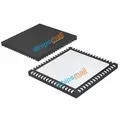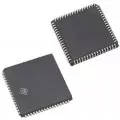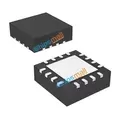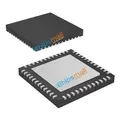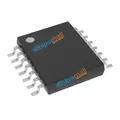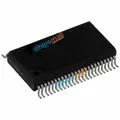OUTLINE:
Introduction: what is PIC microcontroller
 147
147MCU is a microcomputer that integrates the central processing unit (CPU), memory, input and output interface (I/O interface), etc., on an integrated circuit chip. PIC microcontroller is a series of microcontroller products produced by Microchip Company in the United States.
PIC microcontroller is like a small brain, with its own computing function and memory, run by software control. It realizes the control of external devices by receiving instructions, processing data and performing operations.

Working principle of PIC microcontroller
The working principle of the PIC microcontroller is based on the RISC architecture, which is characterized by a simple instruction set and high execution efficiency. The instruction set of a PIC microcontroller usually contains 33, 35 or 58 instructions, which can be completed in one cycle, greatly improving the overall operation efficiency. In addition, the PIC microcontroller adopts Harvard dual-bus structure, which enables the access of program memory and data memory to be processed in parallel, further improving the running speed.
The normal operation of a PIC microcontroller can be simply understood as a microcomputer control process that processes the input data by executing the instructions stored in the program memory in advance, and outputs the processing results to external devices.
Step 1: Program storage and instruction execution
PIC microcontroller contains program memory, which is used to store the program code written. These codes consist of a series of instructions that guide the microcontroller how to perform various operations.
When the microcontroller is powered on or reset, it reads instructions from the starting address of the program memory and executes them one by one.
The execution process of instruction includes three basic stages: finger extraction, decoding and execution. In the fetching stage, the single chip computer reads the instructions from the program memory; In the decoding stage, the single chip computer analyzes the meaning of the instruction; In the execution stage, the MCU performs corresponding operations according to the requirements of the instructions.
Step 2: Data processing and storage
PIC MCU also contains data memory, which is used to store various data generated when the program is running.
Data memory usually includes random access memory (RAM) and special function register (SFR). RAM is used to temporarily store data, and SFR is used to store status or configuration information for specific functions.
The single chip computer processes the data stored in the data memory by executing instructions. The processing may include arithmetic operations, logical operations, data movement, and so on.
Step 3: Input and output control
PIC microcontroller provides multiple input/output ports (I/O ports) for data exchange with external devices.
The input port is used to read the status or data of the external device, and the output port is used to send control signals or data to the external device.
Interrupt is an important way of communication between MCU and external devices. When the external device sends an interrupt request, the single-chip computer will suspend the current program and execute the interrupt service program instead. After the interrupt service program is completed, the MCU returns to the interrupted program and continues to execute.
The timer is a special counter in the single chip microcomputer, which is used to perform timing operations. The timer can send an interrupt request within a certain period of time, thus triggering the corresponding interrupt service program.
Step 4: Program control
The program counter (PC) is an important register inside the MCU, which is used to indicate the address of the instruction currently executed. Each time the MCU executes an instruction, the program counter will automatically add 1 (or jump to another address according to the type of instruction), thus pointing to the next instruction to be executed.
The single chip microcomputer controls the flow of the program through the instruction. Common program flow control includes sequential execution, conditional jump, loop execution, etc. These control structures enable the single chip computer to deal with various complex tasks flexibly.
Internal structure of PIC microcontroller
The internal structure of PIC microcontroller mainly includes the following key parts, which work together to achieve the various functions of the microcontroller.
|
Internal structure of PIC microcontroller |
|
|
Central Processing Unit (CPU) |
The brain of a PIC microcontroller, responsible for executing the instructions stored in the program memory. |
|
Program memory, also known as ROM (read-only memory) or Flash memory |
Includes program memory (store program code) and data memory (store runtime data), is used to store the program code required for the operation of the microcontroller. |
|
Data storage, also known as RAM (random access memory) |
It is used to store temporary data and variables generated while a program is running. Unlike program memory, data memory is volatile, meaning that the stored contents are lost when the power is turned off. RAM usually includes general purpose registers, stack areas, and so on. |
|
Input/output ports (I/O ports) |
The interface of data exchange between the single chip computer and the external device. Digital ports are used to read the status of external devices or send control signals to external devices, and analog ports are used to process analog signals. |
|
Timer or counter |
The timer can send an interrupt request within a certain period of time, thus triggering the corresponding interrupt service program. Counters are used to count external events, such as pulse counts. |
|
Special function register (SFR) |
Used to control various functions and configurations of the single chip microcomputer. These registers usually include control registers, status registers, interrupt control registers, etc. |
|
Interrupt system |
A way of asynchronous communication between a single chip computer and an external device. When the interrupt source (such as external devices, timers/counters, etc.) issues an interrupt request, the MCU will suspend the current program and execute the interrupt service program instead. |
|
Clock circuit |
Designed to provide a stable clock signal for the single chip computer, to ensure that each part of the single chip computer can work synchronously. Clock signal is the basis of MCU operation, and its frequency determines the execution speed of MCU. |
|
Reset circuit |
Used to initialize a single chip computer to a known starting state. When the microcontroller is powered on or the reset button is pressed, the reset circuit will produce a reset signal, so that each register and counter in the microcontroller are cleared or set to the initial value. |
Different types of PIC microcontroller
PIC microcontrollers have a variety of types, such as 8-bit, 16-bit, 32-bit etc., to meet different application needs. Among them, 8-bit MCU is the most common type. According to their specific performance and functions, these products can be divided into basic, intermediate and advanced three levels to meet the application needs of different levels.
Characteristics and practical operation of PIC microcontroller
PIC microcontroller is a series of microcontroller products produced by Microchip Technology (Microchip Technology) company. The following is an introduction of the features and application to 8-bit, 16-bit and 32-bit PIC microcontrollers.
8-bit PIC microcontroller
The 8-bit PIC microcontroller is one of Microchip's earliest series and is widely used in various control systems. They are popular for their low power consumption, high performance and ease of programming.
|
Characteristics and practical operation of 8-bit PIC microcontroller |
|
|
Main features |
Reduced Instruction set (RISC) architecture for fast and efficient instruction execution. |
|
The Harvard bus structure realizes the separation of program memory and data memory and improves the performance of the system. |
|
|
Rich on-chip peripherals, such as timers, counters, and A/D converters, provide developers with more freedom. |
|
|
Low-power design for long run and battery-powered applications. |
|
|
Typical application |
The 8-bit PIC microcontroller is often used in home appliance control, motor control, instrumentation and other fields. |
16-bit PIC microcontroller
With the development of technology, Microchip has introduced 16-bit PIC microcontrollers to meet application scenarios with higher performance requirements.
|
Characteristics and practical operation of 16-bit PIC microcontroller |
|
|
Main features |
Higher processing speed and larger storage capacity enable 16-bit PIC microcontrollers to handle more complex tasks. |
|
More advanced peripherals and functions are introduced, such as the PWM module and UART communication interface. |
|
|
It provides richer interrupt sources and higher interrupt processing capability. |
|
|
It still maintains low power consumption and is easy to program. |
|
|
Typical application |
A 16-bit PIC microcontroller is often used in industrial automation, automotive electronics, medical equipment and other fields. |
32-bit PIC microcontroller
The PIC32 series is Microchip's high-performance 32-bit microcontroller, which combines low power consumption, high performance and rich peripheral resources.
|
Characteristics and practical operation of 32-bit PIC microcontroller |
|
|
Main features |
It adopts advanced RISC architecture and Harvard bus structure to realize high-speed instruction execution and data transmission. |
|
It provides a large capacity program memory and data memory, as well as a wealth of on-chip peripherals, such as USB interface, Ethernet interface, audio processing interface and so on. |
|
|
Supports a variety of programming languages, such as C, C++, etc., and provides a powerful development tool chain, such as MPLAB X IDE. |
|
|
With high reliability and long life, it is suitable for a variety of harsh environments and long running applications. |
|
|
Typical application |
The PIC32 series microcontroller is often used in high-end consumer electronics, medical equipment, automotive electronics and other fields, such as audio accessories, touch screen controllers, motor drivers and so on. |
Final Verdict
PIC microcontroller has been widely used in embedded system and automation control by virtue of its high performance, low power consumption, rich peripheral interface and programmability. Whether it is automotive electronics, industrial control or consumer electronics, PIC microcontroller plays an important role in promoting the intelligent and automated development of various equipment.

Disclaimer: The views and opinions expressed by individual authors or forum participants on this website do not represent the views and opinions of Chipsmall, nor do they represent Chipsmall's official policy.

share this blog to:


